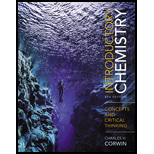
(a)
Interpretation:
The number of valence electrons in elements of Group
Concept introduction:
The periodic table represents elements in order of their increasing
(b)
Interpretation:
The number of valence electrons in elements of Group
Concept introduction:
The periodic table represents elements in order of their increasing atomic numbers. In the modern periodic table, the horizontal rows are known as periods and vertical columns are known as groups. There are seven periods and eighteenth groups in the modern periodic table.
(c)
Interpretation:
The number of valence electrons in elements of Group
Concept introduction:
The periodic table represents elements in order of their increasing atomic numbers. In the modern periodic table, the horizontal rows are known as periods and vertical columns are known as groups. There are seven periods and eighteenth groups in the modern periodic table.
(d)
Interpretation:
The number of valence electrons in elements of Group
Concept introduction:
The periodic table represents elements in order of their increasing atomic numbers. In the modern periodic table, the horizontal rows are known as periods and vertical columns are known as groups. There are seven periods and eighteenth groups in the modern periodic table.
Want to see the full answer?
Check out a sample textbook solution
Chapter 5 Solutions
Introductory Chemistry: Concepts and Critical Thinking Plus MasteringChemistry with eText -- Access Card Package
- What class of elements lies along the “staircase” line in theperiodic table? How do their properties compare with those ofmetals and nonmetals?arrow_forwardWhich of the following accounts for elements in groups exhibiting similar chemical behavior?arrow_forwardWhat is the charge of an oxide ion?arrow_forward
- What is the term for the elements that belong to Groups IIIB-IIB (Groups 3-12)?arrow_forwardA representative element (Z) forms an ion with a 2+ charge. What is the a) Roman Numeral group number for element Z?arrow_forwardTennessine, element 117, is the most recently discovered element in the periodic table. Assuming it behaves as a halogen, what would be the name of the rubidium salt with the tennessine anion?arrow_forward
- Elements that lie on the left side of the periodic table are generally non-metals?arrow_forwardAddress the different grouping/ family of elements in the periodic table and how are they differentiated/ distinct from each other?arrow_forwardWhat are the elements in the A columns of the periodic table called a.Main group elements b. Inner transition metals c. metalloids d. Transition metalsarrow_forward
- What is the formula of cadmium oxide?arrow_forwardShow the locations of (a) alkali metals, (b) alkalineearth metals, (c) the halogens, and (d) the noble gases inthe given outline of a periodic table. Also draw dividinglines between metals and metalloids and betweenmetalloids and nonmetals.arrow_forwardUse the notation to represent a tin ion having the same number of electrons as anatom of the isotope cadmium-112. Explain why there can be more than one answer.arrow_forward
 Chemistry & Chemical ReactivityChemistryISBN:9781337399074Author:John C. Kotz, Paul M. Treichel, John Townsend, David TreichelPublisher:Cengage Learning
Chemistry & Chemical ReactivityChemistryISBN:9781337399074Author:John C. Kotz, Paul M. Treichel, John Townsend, David TreichelPublisher:Cengage Learning Chemistry & Chemical ReactivityChemistryISBN:9781133949640Author:John C. Kotz, Paul M. Treichel, John Townsend, David TreichelPublisher:Cengage Learning
Chemistry & Chemical ReactivityChemistryISBN:9781133949640Author:John C. Kotz, Paul M. Treichel, John Townsend, David TreichelPublisher:Cengage Learning Introductory Chemistry: An Active Learning Approa...ChemistryISBN:9781305079250Author:Mark S. Cracolice, Ed PetersPublisher:Cengage Learning
Introductory Chemistry: An Active Learning Approa...ChemistryISBN:9781305079250Author:Mark S. Cracolice, Ed PetersPublisher:Cengage Learning


